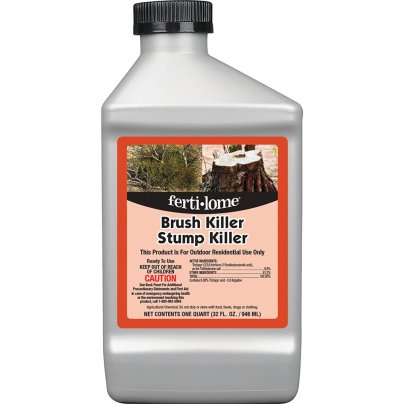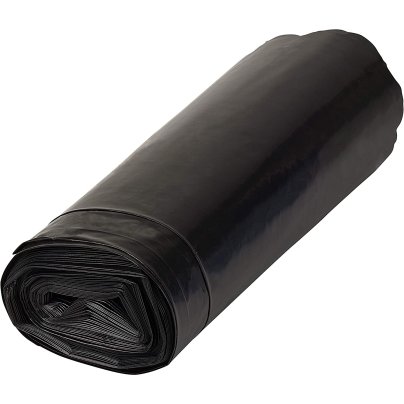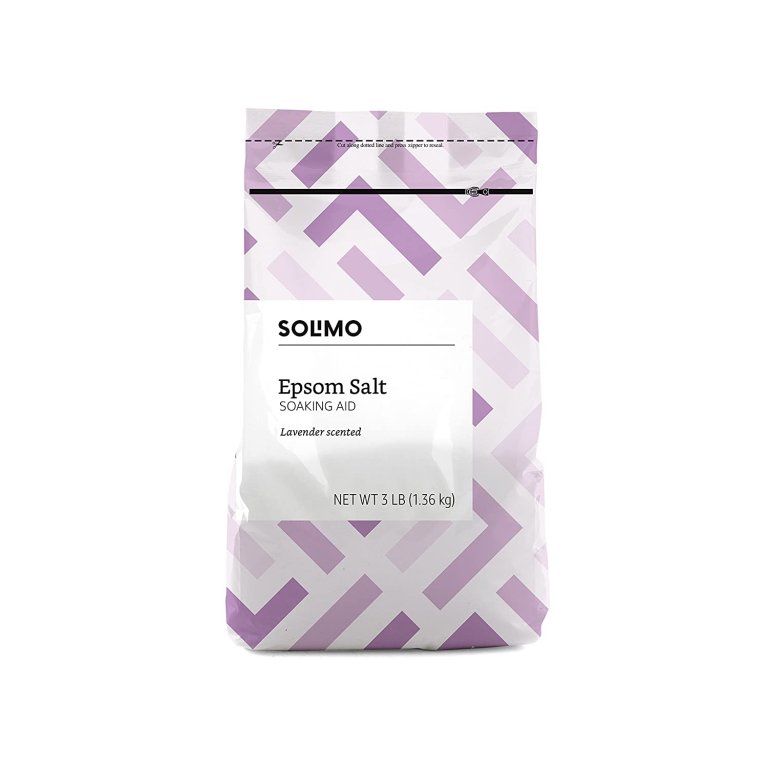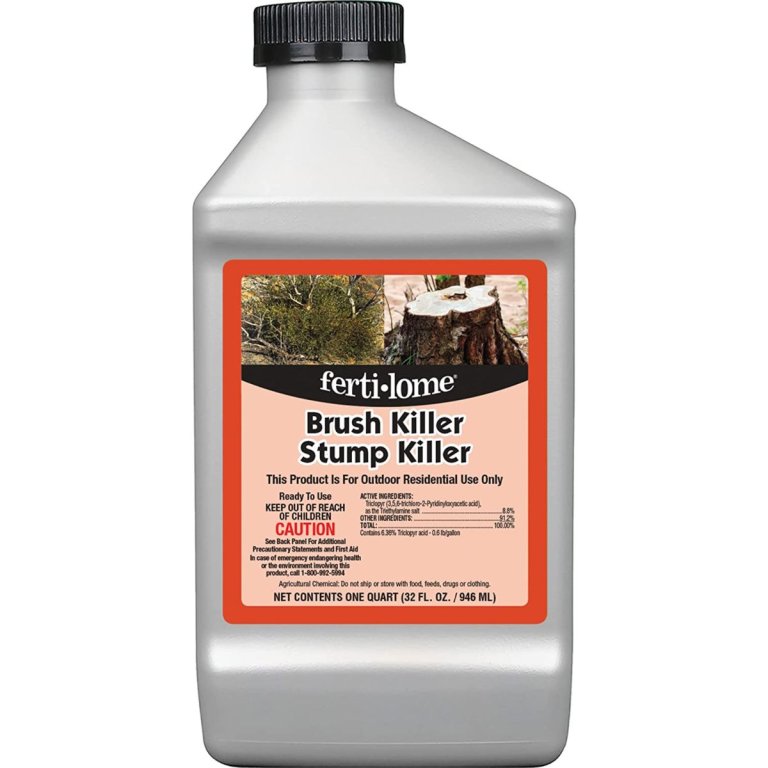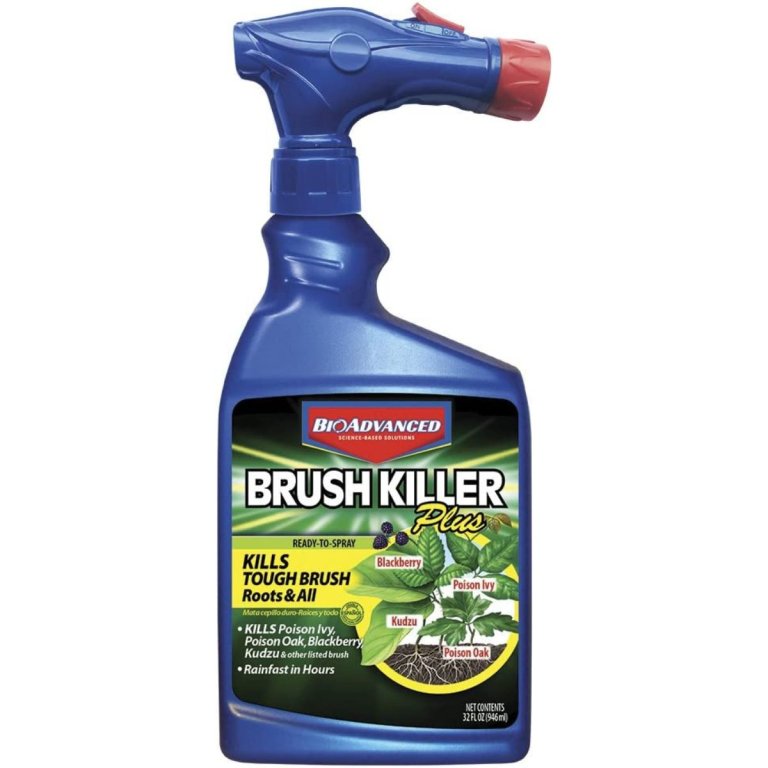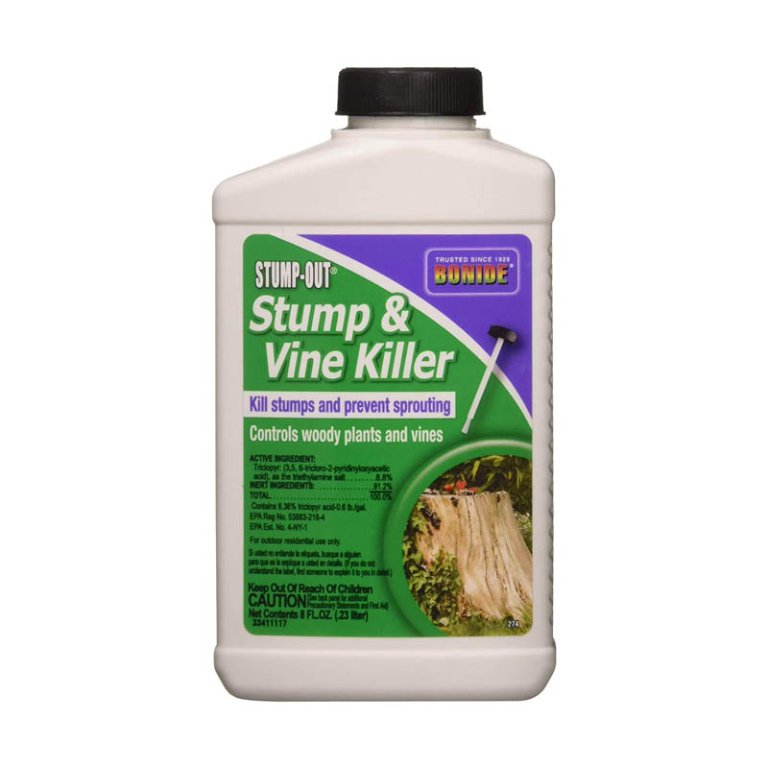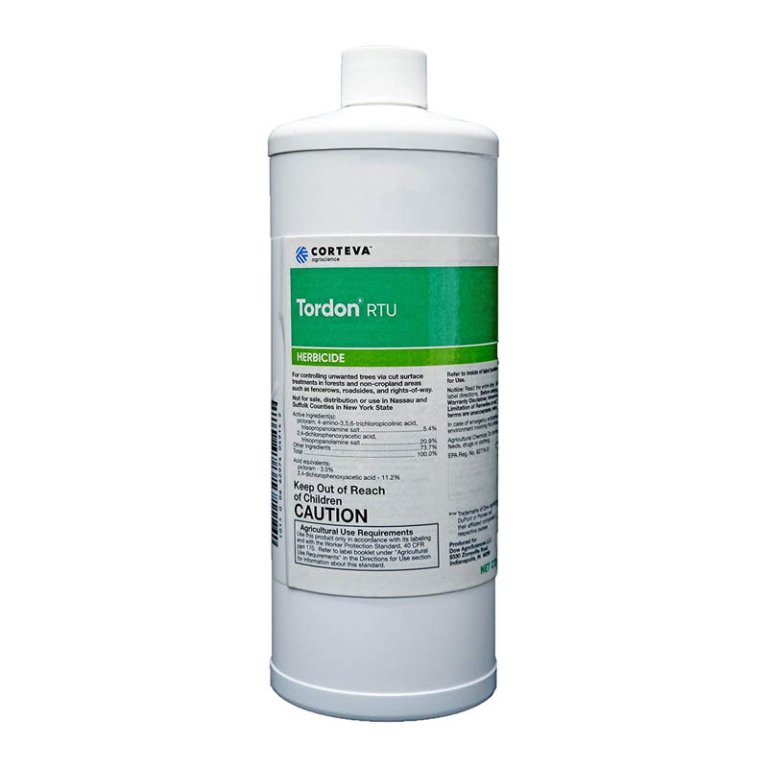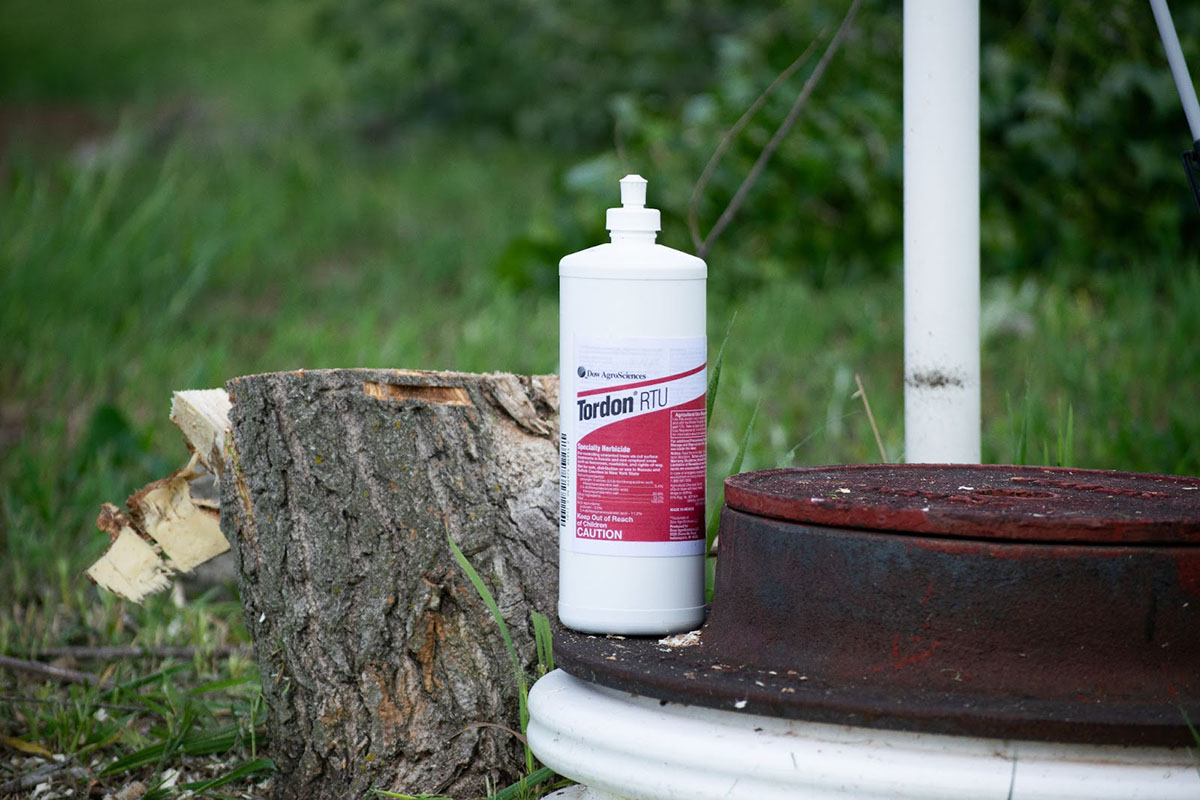
We may earn revenue from the products available on this page and participate in affiliate programs. Learn More ›
Trees are majestic in the landscape, but not all trees are desirable, such as those that grow beneath power lines or right next to fences. The owner may cut the tree down, but the stump and a massive root system remain locked firmly in the ground. Digging or chopping out a stump is challenging at best, and in some cases, nearly impossible without using heavy equipment. Depending on the species—and if the tree or vine was alive when it was cut down—new aggressive shoots may soon appear around the stump, and the problem starts all over again.
One solution? A tree-stump killer, which is an herbicide specially designed to kill a stump and its roots. Tree-stump killers eliminate the need to chop or dig up stubborn stumps, and they prevent new shoots from forming.
That said, some of the most effective stump killers use chemicals such as triclopyr and picloram; these herbicides pose a threat to wildlife and can even cause collateral damage to nearby shrubs and trees. Before reaching for these products, consider using one of the natural alternatives discussed below.
Ahead, discover tips on how to choose the best stump killer for your yard and find out why the following products are among the best options for getting rid of troublesome stumps.
- BEST OVERALL: Solimo Epsom Salt
- RUNNER-UP: Ferti-lome RTU Brush and Stump Killer
- BEST BANG FOR THE BUCK: Frost King Polyethylene Sheeting
- BEST WITH SPRAYER: BioAdvanced Brush Killer Plus Stump Remover
- HONORABLE MENTION: Bonide Stump-Out Stump & Vine Killer
- ALSO CONSIDER: Dow AgroSciences Tordon RTU Herbicide
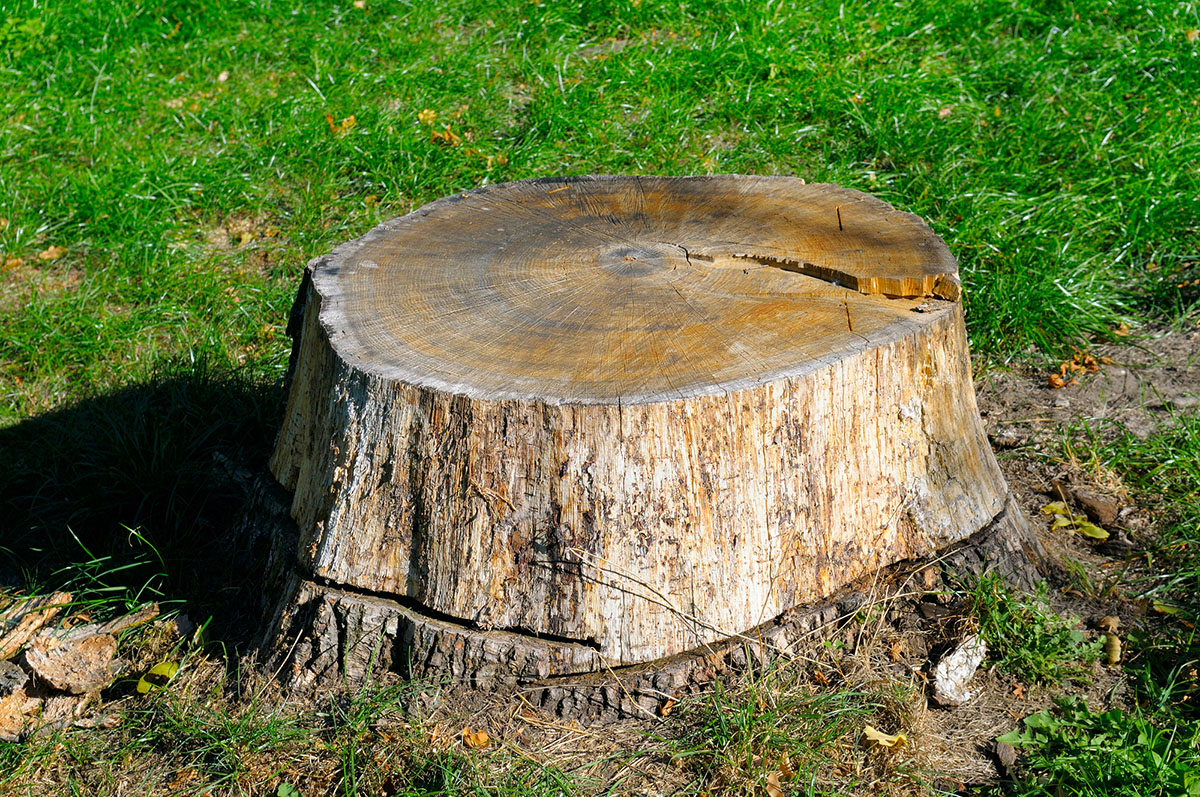
Before You Buy a Stump Killer
Before purchasing a tree-stump killer, it’s important to keep a few factors in mind. First, killing a stump requires some level of patience. Even the most effective chemical herbicide for killing stumps will take around 2 months to kill a stump and another 4 to 8 months for the stump to decompose enough to make removing its remains an easy process.
It’s also crucial to remember that stump killers use herbicides to work their magic. As such, they have the potential to impact the environment negatively. Many tree-stump killers use chemicals such as triclopyr, picloram, and glyphosate that can be harmful to wildlife and can even cause damage to surrounding trees and landscaping.
With this in mind, it’s important to consider products that use natural ingredients that won’t leave a footprint on the environment or alternative methods that don’t require adding any substances to the environment at all, including stump grinding or triclosan composting.
Ahead, learn more about the chemical, natural, and physical options that are available for getting rid of a stump.
How We Chose the Best Stump Killers
We extensively researched dozens of products for this lineup. Brand reputation played a role—reputable manufacturers with well-vetted products that were high on customer satisfaction were given top consideration. Still, we didn’t automatically eliminate lesser-known or niche brands as long as the products contained ingredients known for killing stumps.
We kept in mind that stump-killing needs vary. Some users want to get rid of old, seasoned stumps, so we included products that help dead stumps decompose faster. Others are looking to stop volunteer trees from growing where they shouldn’t be growing, and we also considered that need.
To make our lineup, products had to be effective and reasonably simple to use. We allowed for some dilution because many users prefer a concentrated product. We also included products that require drilling holes in a stump before application, as that may be the best way to kill a stump.
While our selections include herbicide-based products, which are among the most effective ways of killing tree stumps, we also select products that will get the job done while being easier on the environment. These alternatives use natural active ingredients, such as Epsom salt, or physical means, such as plastic barriers, that block sunlight to kill tree stumps.
Our Top Picks
To qualify as one of the top picks, a stump-killing product should effectively destroy the roots of a living tree, brush, or woody vine and prevent regrowth. If the product is designed to remove seasoned stumps, it should hasten the decay of the stump so the owner can easily remove the remaining debris with a shovel.
The following stump-killing/removal chemicals differ in type and function, but each offers a reliable way to eliminate an unwanted stump. If shoppers prefer a nonchemical method, they will want to check out “Do You Need a Stump Killer?” at the end of this guide.
Best Overall
Solimo Epsom Salt
Pros
- Won’t leave behind chemicals that harm the environment
- Nourishes the soil, promoting growth of new plants once the stump is gone
- Can use leftover salt for other purposes, such as alleviating body aches
Cons
- Takes longer to kill the stump than other products and requires multiple applications
Product Specs
- Form: Granules
- Type: Natural
- Application method: Apply to stump and sprinkle with water
- Active ingredient: Salt
While most people think of Epsom salt as a cure for aching muscles and feet, this versatile product will also kill a tree stump. And, it will do so without harming the environment. In fact, users will be salting the earth after conquering that stump, adding nutrients to the soil that will promote growth of new plantings.
To use, drill inch-wide holes in the tree stump using a power drill and an auger or large drill bit. Cover the stump with salt, sprinkle it with water, then cover with a tarp to prevent the salt from being washed away in the rain. Repeat the process every few weeks until the stump dies and begins to rot.
Get the Solimo stump killer on Amazon.
Runner-up
Ferti-lome RTU Brush and Stump Killer
Pros
- Solution strength adjustable depending on need
- 1 gallon of solution treats up to 500 square feet
- Kills on contact with foliage
Cons
- Mature trees may require additional treatment
Product Specs
- Form: Concentrated liquid
- Type: Chemical
- Application method: Dilute and spray
- Active ingredient: Triclopyr
Triclopyr is the active chemical ingredient in Ferti-lome’s Brush and Stump Killer that’s designed to kill tree roots and stop invasive shoots from growing. It’s also helpful in speeding the decomposition of the stump. Triclopyr, Ferti-lome’s active ingredient, can be toxic to birds, so it should be used sparingly. Limit its use to small stumps up to about 6 inches in diameter and woody brush and vining stumps, such as those associated with poison ivy or wisteria.
The concentrated chemical comes in a 32-ounce bottle and should be diluted at the rate of 8 to 16 tablespoons per gallon of water. Use the highest concentration for hard-to-kill stumps such as poison ivy. Once mixed with water, the solution is painted on the stump with a paint brush.
Get the Ferti-lome brush and stump killer on Amazon or at Ace Hardware.
Best Bang For The Buck
Frost King Polyethylene Sheeting
Pros
- Plastic sheeting is a cheap way to kill a stump and can be reused
- Wide sheeting is capable of covering most tree stumps
- Can be used for a variety of other needs
Cons
- Takes longer to kill a tree stump than chemical-based alternatives
Product Specs
- Form: Plastic sheeting
- Type: Natural
- Application method: Cover the stump in plastic sheeting and dead organic material
- Active ingredient: N/A
While using chemicals is one way to kill a tree stump, a cheap and easy method is to deprive it of sunlight using this plastic sheeting from Frost King. To use this sheeting, cut the stump as close to the ground as possible, then cover the stump and its exposed roots with the sheeting. Pile about a foot of organic waste onto the tarp for good measure and wait it out.
The stump will be starved of sunlight, slowly killing it. With its 3-foot width, this plastic sheeting is large enough to cover a good-size stump. It’s also 4 mil thick, which means it will resist punctures and block out sunlight more effectively. What’s more, when the stump is dead, the plastic sheeting can be reused for another one.
Get the Frost King stump killer on Amazon.
Best with Sprayer
BioAdvanced Brush Killer Plus Stump Remover
Pros
- No mixing required before use
- Hose-end sprayer included for easy application
- No need to saw or drill holes before applying
- Suitable for treating large woody areas
Cons
- May not be strong enough to kill mature trees
Product Specs
- Form: Concentrated liquid
- Type: Chemical
- Application method: Hose-end sprayer
- Active ingredient: Triclopyr
For no mix or mess, check out BioAdvanced Brush Killer Plus Stump Remover that comes in a ready-to-use spray bottle. The product is best for small stumps that are commonly associated with woody bushes and vines, including kudzu and poison oak. BioAdvanced is an all-purpose herbicide that also kills noxious and invasive species.
Spray the product, which contains the active ingredient triclopyr, until all exposed surfaces on the stump are thoroughly wet but not dripping. Also saturate any new shoots that may be growing from the stump. BioAdvanced is formulated to penetrate deep into the stump and work its way down to the roots; it will kill and hasten decomposition.
Get the BioAdvanced stump killer on Amazonor at Ace Hardware.
Honorable Mention
Bonide Stump-Out Stump & Vine Killer
Pros
- Can be used on fresh stumps; no wait time before applying
- Applicator included makes it easy to apply
- May also be diluted as a foliar spray
Cons
- Overspray can kill desirable plants
Product Specs
- Form: Ready-to-use liquid
- Type: Chemical
- Application method: Brush on for full strength
- Active ingredient: Triclopyr
Kill small stumps without harming nearby vegetation with Bonide Stump-Out Stump & Vine Killer, which contains the active ingredient triclopyr. This ready-to-use liquid comes in an 8-ounce bottle and features an included brush-top applicator for painting the product directly onto the surface of the stump. It works well on small to medium tree stumps up to about 8 inches in diameter. Alternatively, users can dilute the product in water and use it in a pump-type sprayer to apply to the foliage of invasive vines.
It’s also suitable for use on the stumps of other woody and vining plants, such as poison oak and wisteria. For the best results, apply this Bonide product to freshly cut stumps and coat as much of the stump surface as possible.
Get the Bonide stump killer at Ace Hardware.
Also Consider
Dow AgroSciences Tordon RTU Herbicide
Pros
- One of the fastest ways to kill a tree stump
- Ready-to-use mix makes it easy to apply
- Prevents new shoots from growing
Cons
- Can kill nearby plants and even trees if not careful
- Presents a hazard to the environment and can be toxic to people
Product Specs
- Form: Ready-to-use liquid
- Type: Chemical
- Application method: Apply to cambium
- Active ingredient: Picloram, dichlorophenoxyacetic acid
While the stump-killing active ingredients in Tordon may not be easy on the environment, it doesn’t take a lot of this product to work. When used responsibly, Tordon can be a very effective and reasonably safe way of killing an offending tree stump. To use, apply Tordon only in the ring that circles the stump where the bark meets the wood, which is called the cambium. From there, it will soak into the stump’s root system, killing off any living tissue.
Resist the urge to saturate the stump. Doing so will cause the excess chemicals to run off into the soil. Not only will using more Tordon not speed up the stump-killing process, it wastes the products, creates more of an impact on the environment, and could even damage nearby trees if it finds its way to their root system. If the tree is near a steam, lake or other body of water, don’t use this product.
Get the Dow AgroSciences stump killer at Amazon or Tractor Supply Co.
Jump to Our Top Picks
Our Verdict
Some stump-killing products may work faster and require fewer applications, such as Tordon RTU and Spectracide Stump Remover; however, they do not meet our sustainability guidelines. The Solimo stump killer (our Best Overall pick above) will get the job done without leaving harmful chemicals in the soil or harming nearby trees, shrubs, and plants. It’s also safe for use around pets and people and doesn’t present a threat to wildlife. Those looking for a faster way to kill a tree stump will want to consider the Ferti-lome stump killer (our Runner-Up pick), which will also take out tough-to-kill weeds, such as poison ivy.
What to Consider When Choosing a Stump Killer
Tree-stump killer isn’t a quick-fix solution for getting rid of stumps; the degradation process can take from a few months to a year. Eventually, the stump will decompose, and the hole that’s left behind can be filled in and smoothed over. Shoppers will want to consider the following when shopping for a tree-stump killer, and if they’re not sold on using a chemical to get rid of a stump, they may want to check our alternative suggestions later in this guide.
Stump Size and Location
The size of the stump is a significant factor in deciding whether to remove it manually or chemically. Stumps that sit a couple of inches above ground level can pose a tripping hazard. If the stump is in a part of the yard that sees frequent foot traffic, it might be better to have it manually removed for safety purposes.
Chemical stump-removal products help kill any size stump that would be challenging to remove manually. Smaller stumps that are less than a couple of inches in diameter may be worth digging out to get rid of them sooner.
Working Time
The actual time it takes a chemical stump remover to decompose a stump can vary depending on the tree or plant species and whether the stump is green and freshly cut.
In the case of newly cut stumps, a stump-removal herbicide that travels to the roots is necessary to stop resprouting. Depending on the product, results may appear within 6 to 8 weeks. The stump itself, however, may not decompose for another few months.
Another type of stump that’s a good candidate for chemical removal is a dead or “seasoned” stump. Although these stumps are incapable of sending up new shoots, they can be hazardous or stand in the way of new landscaping plans. In this case, the stump-removal product will contain a chemical that hastens the degradation of the old wood, which can take a few months or longer.
After a few months, the owner may be able to pour kerosene on a partially decomposed seasoned stump and burn it. Some chemical stump-remover products are designed to be used in conjunction with stump burning. Before going this route, check with local fire codes to see if burning the stump is permissible in the community.
Ingredients
Chemical tree-stump killers contain potent herbicides and other chemical components that hasten stump decomposition. Most stump-removal products contain one or more of the following active ingredients:
- Glyphosate: Glyphosate is a broad-spectrum herbicide that travels within the stump’s vascular system to kill the roots. It’s useful in killing green stumps.
- Triclopyr: Triclopyr is a systemic herbicide that tricks the living roots of a stump into rapid growth that overwhelms the tree and kills it. Triclopyr is found in products that kill green stumps.
- Potassium nitrate: Also called “saltpeter,” potassium nitrate not only kills the stump, but it’s also one of the best ingredients for helping it decompose quickly. It’s found in products for killing green stumps or decaying seasoned stumps.
- Picloram: Picloram is a systemic herbicide that destroys woody-type plants. This herbicide is found in products designed to both kill and decompose the stump.
- Sodium metabisulfite: Sodium metabisulfite is an inorganic chemical that helps decay seasoned tree stumps. It’s not meant for use on green stumps that may regrow.
Safety
The chemicals in tree-stump killers are often toxic and can irritate skin and eyes or trigger respiratory symptoms if the fumes are inhaled. The manufacturer will usually suggest wearing chemical-resistant gloves and goggles. Consider wearing a respiratory mask and protective clothing for ultimate protection, including long pants and a long-sleeve shirt. Keep children and pets away when treating the stump, and cover the treated stump with a tarp or board during the decomposition process.
Some types of stump remover, especially those containing potassium nitrate, are flammable, so don’t use them near an open flame or smoke during application.
Application Process
Various chemical tree-stump killers may come with slightly different instructions, but the following application method is standard:
- Using a chainsaw, cut the stump low to the ground and remove side bark to reveal as much surface area as possible.
- Drill holes in the surface of the stump (more than a few inches in diameter). Alternatively, use a chainsaw to cut grooves on the stump’s surface.
- Apply the chemical tree-stump killer or decomposing agent. Depending on the product, this might mean sprinkling granules in the holes and then pouring hot water over the stump. It might also mean painting a liquid on the surface of the stump or spraying it. Spraying is usually reserved for stumps with green sprouts, and the sprouts are sprayed as well.
- Cover the stump to keep kids and animals safe.
- Check on the stump every 3 to 4 months. Eventually, it will become spongy and can be dug out or burned. Simply remove the ash.
Do You Need a Stump Killer?
Unwanted trees and shrubs do cause problems; their roots can penetrate drainage lines and they can ruin the look of a well-manicured landscape. While one’s first instinct might be to reach for a tree-stump killer, there are several nonchemical solutions to unwanted stumps that are very effective.
- Grinding: Professional stump-removal companies use large machines to grind away tree stumps below the level of the yard, and then the roots of the stump can be covered with soil and planted with grass to match the rest of the yard. The cost of having a stump ground down will vary, but expect to pay in the ballpark of $150 to $450, depending on the stump’s diameter.
- Natural stump killer: Vinegar and Epsom salt will both kill a green tree stump and keep it from coming back up from the roots, although it will take longer than a chemical tree-stump killer. Here’s how to kill tree stumps naturally: drill holes in the stump’s surface and fill them with white vinegar or Epsom salt. Users may need to retreat the stump a couple more times if shoots appear.
- Try composting: Eventually, a dead stump will decompose, but it could take years. The process can be hurried along by creating a compost pile right over the stump. Construct a cage around the stump using something like chicken wire and then fill it with dry leaves and vegetable food waste. Water occasionally to keep the compost damp. As the material biodegrades, it will encourage the stump to decompose more quickly.
- Incorporate the stump into the landscape: Upcycling a tree stump to support a small bench or table (depending on height) can add a whimsical touch to the yard, and no chemicals are needed. Think creatively—a taller stump could even serve to hold a bird bath or squirrel feeder.
- Digging it out: This method requires a significant amount of physical effort, especially for larger stumps. However, for those who don’t mind the labor and have the back for it, digging out a stump is an option. Use a pointed shovel to remove the soil around the stump, employing loppers and a reciprocating saw to remove roots along the way. Use a metal bar or saw to remove the taproot under the root ball. Once all roots are cut, push the stump over and roll it away.
FAQs
Clearing out underbrush or removing woody shrubs and trees can leave unsightly stumps that must be removed before the area can be used for other purposes. Stump killers are designed to either kill a green stump that might otherwise send up shoots or decay an already dead stump, softening it and making it easy to remove. For those looking to use this type of product for the first time, some questions are to be expected.
Q. Should I remove my tree stumps?
To keep new tree sprouts from regrowing, it is often necessary to remove the stump. A stump also poses a tripping hazard and can wreak havoc on the blades of a mower.
Q. Which chemicals will kill a tree stump?
Chemicals such as glyphosate, triclopyr, picloram, and potassium nitrate are frequently found in chemical stump removers designed to kill a stump and hasten its decay.
Q. How long does it take to kill a tree stump?
Depending on size, it shouldn’t take more than an hour to prep most stumps and apply a chemical product. However, it could take a few months or longer for the stump to decompose sufficiently for removal.
Q. How do you apply tree-stump killer?
Application varies by the type of product but typically holes should be drilled in the stump’s surface and then filled with granules or a liquid chemical.

